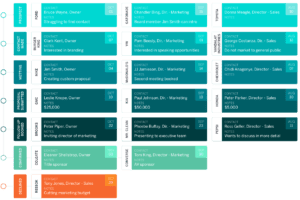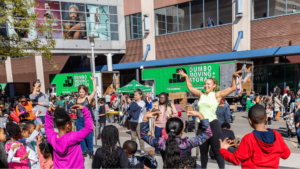Sponsorship is a multi-billion dollar industry, and its annual growth has surpassed advertising and other forms of marketing, including public relations, direct marketing, and promotions. Historically, event sponsorship has been transaction-based, where events like yours would identify generic forms of exposure — like tickets, trade show booths, and logo placements — for brands to sponsor, then sell those assets. This templated approach has run its course and is no longer how to ask for sponsorship for events. “Brands — especially big name brands — receive up to 10,000 unsolicited sponsorship proposals a month,” says The Sponsorship Collective president and CEO Chris Baylis. “If you and your team hope to win and retain sponsors today, you must adapt your strategy to create long-term relationships with sponsors.”
There have been many changes to events and event planning in past years due to the COVID-19 pandemic, and those changes have also affected event sponsorship. The prevalence of virtual events has grown, which means the ways in which companies can sponsor events have changed. Many organizations have been faced with budget cuts, meaning creators need to procure financial assistance from sponsors to hold an event at all. Coupled with these changes is an overall increase in consumer awareness, which means your potential attendees care about the sponsors your event is aligned with, what those sponsors stand for, and if their involvement in your event makes sense. As a creator, you need to be thinking critically about the sponsors you want to approach, what your association with those sponsors will say to your audience, and how your relationship with a sponsor can be mutually beneficial. This may sound like a lot of work, but if you put in the effort to establish meaningful connections with sponsors, those partnerships will be easier to secure and carry through to many future events.
We’ve put together this guide with tips and examples that will help you improve your ability to attract and retain event sponsors.
1. Determine who should sponsor your event
You can figure out what sponsors to approach by understanding what your audience is looking for. Research event sponsorship examples from successful events and you’ll see that the best sponsorships are from companies that connect with your potential attendees and make sense with your event’s theme and goals.
- Analyze your event audience to find out what makes them tick
- Using your audience insights, find companies and brands that are also trying to sell to your audience
- Create a wishlist of ideal sponsorship companies to approach

2. Work your way to the decision-maker — it’s worth it
There are a number of ways to find the sponsorship decision-maker at the company you’re interested in partnering with. Attending an event your potential partner is sponsoring, for example, is a great way for you to make connections. Social media is another good channel for reaching out to a potential sponsor — like sending an InMail message on LinkedIn. This is a time-intensive, but incredibly important, process.
Ask each person you speak to for insight into their business. Along the way you’ll discover which sponsorship opportunities are more viable for their business, and by the time you reach the decision-maker, you’ll have a better idea of how to pitch your event to them.
Sponsorship decisions aren’t made in isolation. Decision-makers will want to get buy-in from other areas of the business. If you’ve done your due diligence and asked every connection the right questions, you’ll have qualified the opportunity for them.
- Attend events that potential sponsors are attending or sponsoring
- Reach out to warm connections via social media (i.e., LinkedIn InMail)
- Ask everyone you contact for insight into their business
- Take detailed notes of each conversation and validate everything you’ve learned with the next person you speak with
3. Approach event sponsors with brevity
As you begin to approach potential sponsors, remember that your first goal is not to sell sponsorship — it’s to find the decision-maker and ask for a meeting after you do.
Keep your event sponsorship proposal to two or three brief sentences and demonstrate an interest in their goals and challenges.
The examples below demonstrate how to write a sponsorship letter for an event that seeks out the decision-maker and asks for a meeting. Although they’re presented here as emails, you can easily use them to guide your conversations on social media, over the phone, or in person.
The follow-up/warm email
This email sample shows how you would follow up with a connection made at an event. Instead of leading with the proposal, take the time to gather information and learn who’s who at the company. The example below is great because it doesn’t bombard your contact with information that is potentially irrelevant to them.
Hey there,
It was great to meet you last week at (name of the event). Any chance you can suggest the best contact for those in the (related product/project) side at your company?
Thanks,
Your Name
The cold email
If you’re not fortunate enough to make a warm connection first, going in cold shouldn’t be a problem with this sample email. Keep it brief, and offer a date and time. In the example below, the writer asks which time works for the person they’re contacting, not whether they want to meet. This is a more direct question that reduces the likelihood that the person you’re emailing will decline to speak with you.
Hey there,
I saw on LinkedIn that you are involved in (related product/project). I would love to connect and ask your thoughts about an interesting project I’m working on.
Are you free tomorrow at 3:00?
Your Name
The meeting request
Once you’ve identified the decision-maker, the next step is to request a meeting with them. This example shows how you’d follow through with an introduction to the decision-maker and request a meeting. The message focuses on the prospect and offers a date and time to discuss a potential opportunity that will be mutually beneficial.
Hi (Prospect’s Name),
Your colleague, (colleague’s name), mentioned you were the manager for (related product/project).
I would love to set up a quick call to discuss some of your areas of focus and see if there is some common ground between your priorities and our plans for 2022.
How does your schedule look on Wednesday? Does 3:00 work for a phone call?
Thanks,
(Your Name)
Remember:
- Never send your entire prospect list a 600-word email with a proposal attached
- Don’t ask for the sale yet — find the decision-maker and ask for a meeting first
- Keep your messages to two or three brief sentences and demonstrate an interest in their goals and challenges
- Offer a date and time — ask which time works for them, not whether they want to meet
- Take the time to gather information and learn who’s who at the company
4. Track your progress and analyze your outreach efforts
You will likely need to approach a number of potential sponsors before you find the companies that you ultimately work with, so it’s important to keep track of your progress so you can stay organized. As you begin to approach sponsors and work on finding the decision-makers you need to speak to, take notes on the conversations you have along the way.
The flow chart below is one example of how to track your sponsorship progress in a visual way. It’s easy to see what stage you’re at with each potential sponsor, who your contact is, what next steps are, and potentially how much money the sponsor may potentially provide.

“Event sponsorship is a relationship business,” says Baylis. “Counting how many emails you’ve sent can’t measure that. Remember that your best sales tool isn’t your proposal or package — it’s you.”
- Instead of counting proposals, break down the entire sales process into the main stages that lead to a sale (Contact Made, Meeting, Proposal Submitted)
- Focus on counting steps that get you from one stage to the next
5. Build long-lasting partnerships with sponsors
Procuring sponsors shouldn’t be a cold, transactional process. You want to build rapport with like-minded companies whose support will elevate your events. This takes more time and careful planning than sending out the same templated proposal to all of your potential sponsors. The more you think about how to create mutually beneficial relationships with your sponsors, the better the foundation you build with your contacts will be. This means that when you reach out to those same contacts in the future, they understand your values and know that sponsoring your events is worth their while.
Need some more guidance? Get in touch with our event experts by contacting us here or calling (877) 620-9578.
Ready to reach out?
It’s not just important to have a great event sponsorship proposal — you also want your event page and marketing materials to reflect the quality of your upcoming event. Eventbrite makes creating a great-looking event page and promoting it to your audience easy. In 2020, nearly 75 million attendees registered for more than one million virtual events on Eventbrite.
Sign up for Eventbrite to find and procure sponsors, promote and manage events, handle on-site operations, and analyze results across multiple sales channels.






